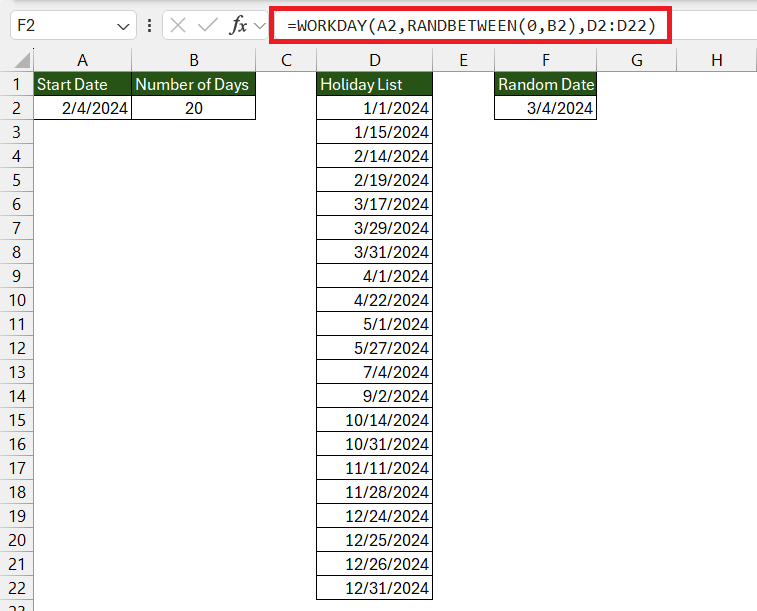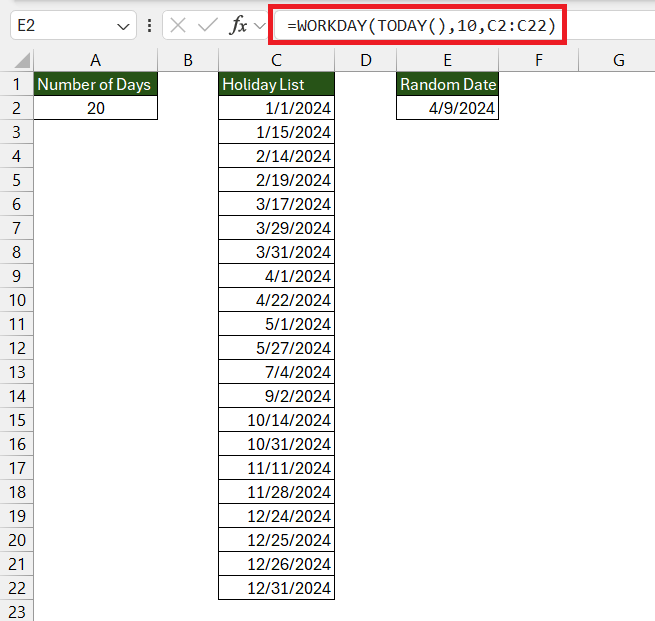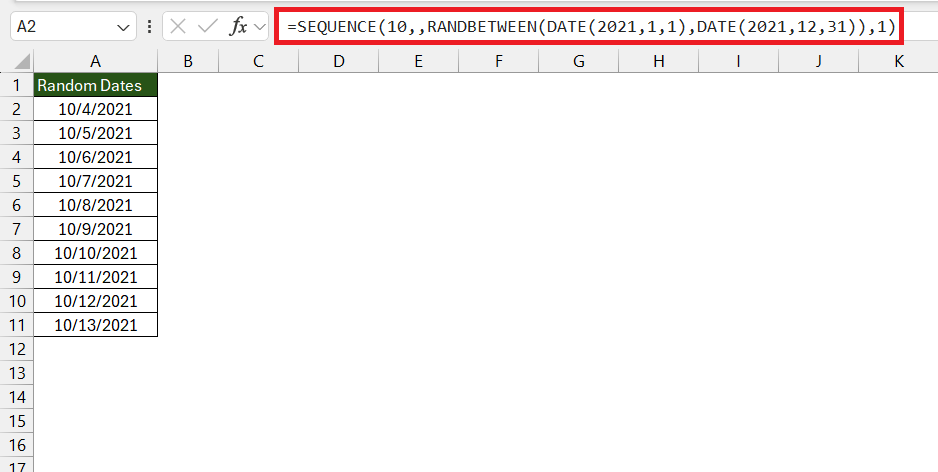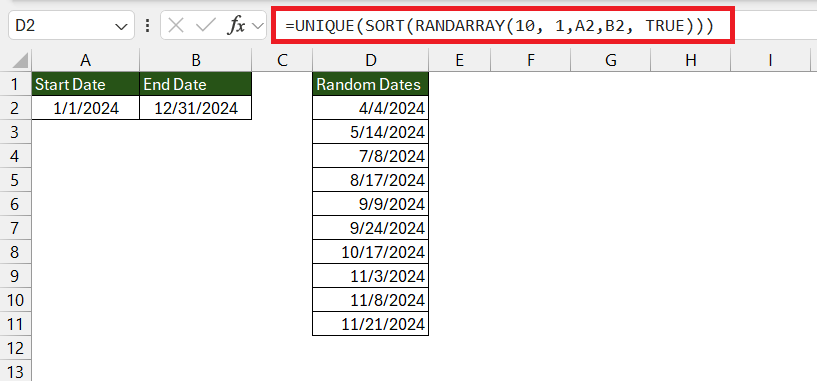Microsoft Excel is a powerful tool for random date generator, serving various needs from project simulations to testing software. With its comprehensive functions, Excel allows users to effortlessly create hypothetical timelines and sample datasets, enhancing the realism and utility of your data analysis.
Key Takeaways
- RANDBETWEEN and DATE Functions: Utilize these functions together to generate random dates within specific ranges, enabling precise simulations and analyses.
- Workday Considerations: Use WORKDAY and WORKDAY.INTL to exclude weekends and holidays, creating realistic work schedules and timelines.
- RANDARRAY for Bulk Generation: For generating multiple dates simultaneously, RANDARRAY combined with RANDBETWEEN can produce arrays of random dates efficiently.
- Ensure Data Diversity: Incorporate varying intervals and conditions in your random date formulas to reflect different scenarios and prevent data clustering.
- Streamline with Shortcuts and Macros: Leverage Excel’s shortcuts and macros for efficient random date generation, saving time and ensuring consistency in repetitive tasks.
Table of Contents
Unleashing the Power of Excel for Random Dates
Why Generate Random Dates in Excel?
Random date generator in Excel can be incredibly useful for numerous scenarios. They assist in performing simulations for project planning, creating hypothetical timelines, or generating sample datasets for testing software. Excel, with its robust suite of features, offers a versatile platform to create these dates effortlessly.
Key Tools for Date Generation in Microsoft Excel
Excel boasts several built-in tools that make generating random dates a breeze. Chief among them is the RANDBETWEEN function, which allows you to create a random number—hence a date—within a specified range. Combine this with the DATE function for precise control over the year, month, and day. Another powerful toolkit is the Analysis ToolPak, which provides additional capabilities and convenience for complex data analysis tasks.
The Magic of RANDBETWEEN: Your Go-To Formula
Understanding the Basics of RANDBETWEEN
The RANDBETWEEN function in Excel is designed to generate random integers between two specified values, which can also include dates since Excel treats dates as serial numbers. By inputting a start and end date using the DATE function to define the range, RANDBETWEEN will output a random date within this specified period. To ensure the result is displayed correctly, it must be formatted as a date in Excel.
Crafting Custom Random Date Ranges
Crafting custom random date ranges in Excel requires a blend of functions to yield the desired results. Start with RANDBETWEEN to generate a random number that represents the date. Use this number as the day argument in the DATE function, which can be set up as DATE(year, month, RANDBETWEEN(dayStart, dayEnd)).
For more control over your output:
- Designate a Start and End Date: Set up your range boundaries with specific start and end dates.
- Apply
WORKDAY: To skip weekends, wrap theRANDBETWEENin theWORKDAYfunction. - Account for Business Holidays: Use the
WORKDAY.INTLvariant with a custom weekend parameter and a list of holidays for even finer tuning. - Ensure Realism: Space out dates using additional parameters or logic, such as
RANDBETWEEN(rangeMinimum, rangeMaximum)specifying the variance in days between each date.
Leverage this by experimenting with different setups that suit your needs.
Advanced Techniques for Realistic Date Simulation
Combining Functions for Greater Flexibility
To achieve greater flexibility in date generation, you can combine Excel functions in creative ways. Using RANDBETWEEN alongside a DATE function forms the basis of random date generator. To refine your random dates, consider adding WORKDAY or WORKDAY.INTL functions to exclude weekends and holidays. By combining these, you can simulate realistic work schedules and deadlines.
For example, to generate a random workday within a range, use:
This combination respects weekends and holidays, offering a powerful way to generate dates that mimic real-life scenarios.
Generating Work-Specific Dates with WORKDAY
When your objective is to simulate a work environment with specific timelines, the WORKDAY function in Excel rises to the challenge. It calculates future or past workdays, excluding weekends and optionally holidays, from a given start date. You’ll enter a start date, a number of days to add or subtract, and an optional list of holidays if needed.
For instance, to find a deadline date 10 days from now, excluding weekends and holidays, you’d use:
This combination excludes weekends by default but also allows the inclusion of a holiday range to skip holidays.
Beyond Basics: Using RANDARRAY for Multiple Dates
Bulk Date Generation Made Simple
Excel’s RANDARRAY function, introduced in newer versions such as Excel 365, takes bulk date generation to the next level. This dynamic array formula is ideal for generating multiple random dates in one go. Simply specify the number of dates needed, and RANDARRAY in conjunction with RANDBETWEEN will fill the cells with an array of unique random dates.
Here’s a basic example of how to generate an array of 10 random dates within a given year:
The function creates a sequence of ten dates, starting from a random date between January 1 and December 31, 2021. The last argument ‘1’ indicates that dates are in single-day increments.
Unique Approaches to Random Date Arrays
For more sophisticated date array creation in Excel, tailor the RANDARRAY function to produce arrays that adhere to your specific criteria. By combining RANDARRAY with other functions like SORT and UNIQUE, you can generate non-repeating, sorted date lists.
To generate an array of unique random dates:
This combines the power of generating random dates with sorting them in order and ensuring that each date appears only once. With these techniques, you can create comprehensive sets of random dates that can cater to advanced testing scenarios or intricate sampling methods.
Tips & Tricks for Efficient Use of Excel’s Randomness
Ensuring Diversity in Generated Data Sets
Ensuring diversity in your generated data sets is vital for robust analysis and testing. In Excel, this means creating a variety of dates that accurately reflect different time periods, seasons, and scenarios. Using conditions within your random date formulas, such as RANDBETWEEN combined with logical statements, can help diversify your output.
To further ensure diversity:
- Mix up start and end ranges with varying intervals.
- Use conditional formatting to quickly visualize the range of dates.
- Implement checks to avoid clustering around specific dates or periods.
This approach guarantees a rich, heterogeneous data set that more closely mirrors real-world conditions.
Streamlining Processes with Shortcuts and Macros
Excel not only enables you to generate random dates with formulas but also provides tools to streamline these processes through keyboard shortcuts and macros. Learning key shortcuts can save significant amounts of time, such as Ctrl + ; to insert today’s date or Ctrl + Shift + ; for the current time.
For repetitive tasks, you can record macros—one of Excel’s most powerful automation tools. Macros allow you to capture a sequence of commands to generate random dates and can be triggered with a custom keyboard shortcut. This method is especially useful for complex data generation tasks that you perform regularly.
Keep in mind:
- Macros record your actions exactly, so ensure each step is performed correctly before recording.
- Assign macro shortcuts that don’t conflict with existing Excel shortcuts to avoid confusion.
With macros, you can transform lengthy, repetitive tasks into simple, one-step commands.
FAQ: Expert Answers to Your Excel Questions
Can Excel generate random dates?
Yes, Excel can generate random dates. It uses functions like RANDBETWEEN in combination with the DATE function to create random dates within a specified range. This can be highly useful for simulations, testing, and random sampling in data analysis.
How to generate random date between two dates quickly in excel?
To quickly generate a random date between two dates in Excel, use the formula combining RANDBETWEEN and DATE. Here’s an example:
After entering, apply a date format to the cell to display the random date correctly.
How Do I Ensure Unique Random Dates in Excel?
To ensure unique random dates in Excel, use the UNIQUE function alongside RANDBETWEEN to prevent duplicate date values in your dataset:
This formula generates a list of non-repeating dates between the specified start and end dates.
Can I Generate Random Dates Excluding Weekends and Holidays?
Yes, you can generate random dates in Excel excluding weekends and holidays. Use the WORKDAY or WORKDAY.INTL function to factor in working days and a list of holiday dates:
This will ensure your random dates only fall on business days.
How to change date format on date calculator?
To change the date format on a date calculator in Excel:
- Select the cell or range containing your dates.
- Right-click and choose ‘Format Cells.’
- Under the ‘Number’ tab, click on ‘Date’ and select from the available formats or create a custom format.
- Click ‘OK’ to apply the new format.
John Michaloudis is a former accountant and finance analyst at General Electric, a Microsoft MVP since 2020, an Amazon #1 bestselling author of 4 Microsoft Excel books and teacher of Microsoft Excel & Office over at his flagship MyExcelOnline Academy Online Course.











